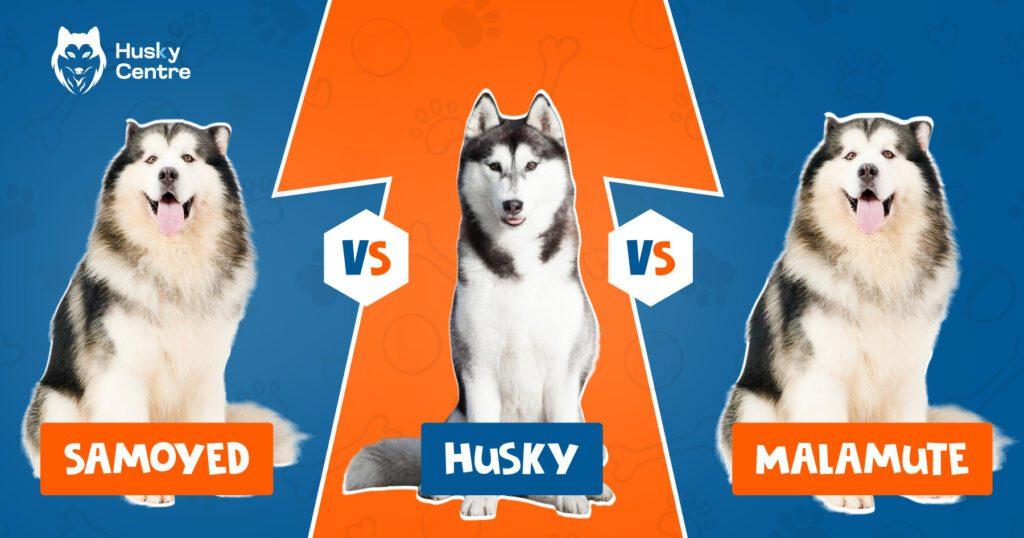Samoyeds, Huskies, and Malamutes are distinct northern breeds with varying sizes and temperaments. Samoyeds are known for their smiling expression, Huskies for endurance, and Malamutes for strength.
Exploring the world of northern dog breeds brings us to the Samoyed, Siberian Husky, and Alaskan Malamute, each possessing unique characteristics that set them apart. Renowned for their thick, white fur and cheerful demeanor, Samoyeds are often recognized for their gentle and friendly nature.
Huskies, on the other hand, are admired for their exceptional stamina and vibrant multi-colored coats, making them born runners of the canine world. Malamutes, the largest of the trio, boast formidable strength and are the heavy lifters, equipped to haul heavy freight over long distances. These breeds share a common ancestry with roots deeply embedded in the Arctic regions where they served as indispensable companions to indigenous people. While they all exhibit loyalty and intelligence, prospective pet owners should consider each breed’s distinct needs and attributes before making a decision.
Breed Origins And Ancestry
Exploring the roots of beloved breeds reveals fascinating tales of survival and evolution. The Samoyed, Siberian Husky, and Alaskan Malamute each boast a rich heritage, deeply entwined with human history.
Samoyed: From Siberian Nomads To Show Dogs
Samoyeds trace back to the nomadic Samoyedic people of Siberia. They relied on these dogs for herding and warmth. The breed’s fluffy coat served as a blanket against the cold. Today, this amicable breed adorns dog shows worldwide, but still carries the resilient spirit of its ancestors.
Siberian Husky: A History Of Endurance
The Siberian Husky hails from Northeast Asia. Chukchi tribes developed these dogs to cover long distances quickly. Their endurance became legendary, notably during the 1925 serum run to Nome. Aptly named ‘Husky,’ this breed embodies a history of remarkable stamina and teamwork.
Alaskan Malamute: The Arctic Heavy Lifters
Originating from Alaska, Malamutes were bred by the Mahlemut Inupiaq people. These dogs pulled heavy sledges over arctic terrains. As muscular heavy lifters, they were essential for survival in harsh, icy environments. Despite modern times, Malamutes still bear the hallmarks of their ancestors’ strength.
Physical Traits And Differences
When comparing the beloved Samoyed, Husky, and Malamute, their physical traits stand out. These Arctic breeds share some resemblances. Yet, they have distinct features. Let’s delve into these fluffy powerhouses and their unique characteristics.
Coat Colors And Maintenance
The Samoyed boasts a mesmerizing pure white or cream coat. It’s thick to withstand cold climates. The Husky, known for its striking multi-colored coat, varies from black to pure white, often mixed with grey, sable, or red. The Malamute typically shows off a combination of grey, black, and white hues. Their dense fur serves as insulation.
Regular grooming is crucial for all three breeds. It keeps their thick fur in top shape. A sturdy brush will become your best friend to manage shedding, especially during seasonal changes. These breeds require weekly brushing, ramping up to daily sessions during their shedding seasons.
Size And Stature Comparison
| Breed | Height (inches) | Weight (pounds) |
|---|---|---|
| Samoyed | 19-23.5 | 50-60 |
| Husky | 20-23.5 | 35-60 |
| Malamute | 23-25 | 75-85 |
The Samoyed is fluffy and medium-sized. Huskies are similarly proportioned but leaner. Malamute, the largest, is robust and powerful.
Distinctive Features That Set Them Apart
- Samoyeds have a “smiling” expression, featuring upturned corners of the mouth.
- Huskies often have striking blue eyes or even one blue and one brown eye.
- Malamutes carry a noble and wolf-like appearance with a broader head and curlier tail.
Each breed displays a unique charm. Samoyed’s cheerful grin, Husky’s captivating gaze, and Malamute’s imposing presence are just the start. Their attributes extend beyond looks, influencing personality, behavior, and care requirements. Tailoring your lifestyle to your chosen breed is essential.
Temperament And Behavior
Exploring the temperaments and behaviors of different dog breeds is key when choosing a furry friend. Samoyeds, Huskies, and Malamutes present their own joyful quirks and challenges. Let’s dive into the unique personality traits of each breed and understand how they fit into the family environment and socialize with other pets.
Personality Quirks Of Each Breed
- Samoyeds boast a friendly and sociable nature. They often greet everyone with a smile.
- Huskies, known for their mischievous charm, love to engage in playful banter and can be quite vocal.
- Malamutes carry a noble and loyal demeanor. They may show a strong-willed personality, taking pride in their independence.
Suitability In Family Settings
| Breed | Children Compatibility | Family Integration |
|---|---|---|
| Samoyed | Excellent with kids | Great family member |
| Husky | Good with supervision | Needs active family |
| Malamute | Better with older children | Loyal to the family unit |
Interaction With Other Pets
- Samoyeds often thrive in multi-pet households, showing patience and playfulness.
- Huskies may exhibit a prey drive. Proper introduction and early socialization are vital.
- Malamutes have strong instincts and can be domineering. They require firm and consistent training for a harmonious pet community.
Training Needs And Intelligence
Understanding the training needs and intelligence of Samoyeds, Huskies, and Malamutes is crucial. These breeds may look similar with their fluffy coats and bright eyes, but their learning styles differ. A well-trained dog leads to a happy home. Let’s explore the best ways to train these intelligent breeds and keep them mentally sharp.
Trainability And Obedience Levels
Samoyeds are known for their friendly disposition and eagerness to please, which makes them highly trainable. With positive reinforcement, they learn quickly.
Huskies, with their independent nature, can present more of a challenge. They require consistent and patient training to achieve good obedience levels.
Malamutes, often strong-willed, demand an assertive trainer. They respect leadership and need clear boundaries for optimal obedience.
| Breed | Trainability | Obedience Level |
|---|---|---|
| Samoyed | High | Good |
| Husky | Medium | Variable |
| Malamute | Medium-High | Good with Firm Training |
Mental Stimulation Requirements
- Samoyeds thrive on interactive play and puzzle toys.
- Huskies need frequent exercise and tasks that engage their hunting instincts.
- Malamutes benefit from work-oriented activities and intelligent games.
Common Behavioral Issues And Solutions
Solutions to Common Issues:
- Destructive Chewing: Provide ample chew toys and exercise.
- Excessive Howling: Address with obedience training and social interaction.
- Stubbornness: Remain consistent and patient during training sessions.
Boredom can lead to issues like digging and escaping. To prevent these, it’s vital to fulfill the dog’s exercise needs and offer mental challenges.
Exercise And Activity Levels
Understanding the exercise and activity levels of Samoyed, Husky, and Malamute is crucial if you want to keep these breeds happy and healthy. These breeds share similarities but have differing exercise needs. Let’s explore how to best cater to their energy and keep them well-balanced.
Energy Output: Which Breed Needs More?
Samoyeds, Huskies, and Malamutes all come from working backgrounds. They thrive on good daily exercise. But, there is a ranking in terms of energy levels. We’ll look at each breed’s needs, from the most to the least exercise-demanding.
- Huskies: They top the list with their high energy output. A Husky requires intensive daily exercise to stay calm and content.
- Malamutes: Slightly less demanding than Huskies, Malamutes still crave plenty of exercise. Their strength calls for rigorous activities.
- Samoyeds: Known for their playful nature, Samoyeds need regular exercise but are less intense compared to their Husky and Malamute friends.
Best Practices For Daily Exercise
For these breeds, consistency is key. Each requires a structured exercise regimen to remain fit. Below are some tips for daily workouts.
| Breed | Exercise Duration | Exercise Type |
|---|---|---|
| Husky | 1-2 hours | Running, sledding, hiking |
| Malamute | 1 hour | Weight pulling, long walks, backpacking |
| Samoyed | 30-60 minutes | Playing fetch, jogging, agility training |
The Importance Of Mental And Physical Challenges
Exercise goes beyond the physical for these intelligent breeds. Mental stimulation is also vital. Integrating challenges into their routine can prevent boredom and behavioral issues.
- Use puzzle feeders to make mealtime stimulating.
- Set up obstacle courses for a brain and body workout.
- Practice commands and tricks to sharpen their minds.
- Engage in hide and seek games with treats or favorite toys.
Health And Lifespan Considerations
Choosing a furry companion involves more than just considering their appearance or temperament. Health and lifespan are crucial factors. Both Samoyeds, Huskies, and Malamutes share similar environments and jobs but differ in their health and longevity. Understanding each breed’s needs can help ensure a happy, healthy life for your four-legged friend.
Common Health Issues In Samoyeds, Huskies, And Malamutes
Samoyeds may face issues like glaucoma and hip dysplasia. Huskies are prone to eye conditions and skin issues. Malamutes often deal with joint problems and bloat. Here’s a brief look:
- Samoyeds: Glaucoma, hip dysplasia, heart complications
- Huskies: Progressive retinal atrophy, cataracts, hypothyroidism
- Malamutes: Hip dysplasia, chondrodysplasia, gastric torsion
Average Lifespan And Quality Of Life
Living with joy depends on so many things. Samoyeds generally live for 12 to 14 years. Huskies can enjoy 12 to 15 years by your side. Malamutes often share around 10 to 14 years with their families. Good care can make these years full of health and love.
Preventative Care And Regular Health Check-ups
Love and medical care go hand in hand. Keeping every breed healthy involves regular vet visits and being proactive. Consider the following steps:
- Vaccinations and parasite control
- Regular dental checks and cleanings
- Weight management and proper diet
- Consistent physical exercise
Vet visits can catch or prevent issues early on. Each visit supports a long and joyful life for your beloved pet.
Which Breed Is Right For You?
Are you in search of your new four-legged best friend? With many breeds to choose from, it’s key that you find a perfect match. Samoyeds, Huskies, and Malamutes all boast fluff and personality but vary greatly. Your lifestyle, living environment, and family dynamics are critical factors. Let’s dive into the distinct characteristics of these breeds to find out which one aligns with your world.
Considering Your Living Environment
These breeds thrive in different settings:
- Samoyeds: Adapt well to various climates but need space to roam.
- Huskies: Prefer cooler climates and require ample exercise.
- Malamutes: Suited for cold weather and need a yard to explore.
Note: Apartment dwellers might find Samoyeds more adaptable, given proper exercise.
Aligning Breed Traits With Your Lifestyle
Your daily routine is a deciding factor:
| Breed | Energy | Social Needs | Exercise |
|---|---|---|---|
| Samoyed | High | Very social | Regular walks and play |
| Husky | Very high | Social | Daily vigorous activity |
| Malamute | High | Less social | Strength-based exercises |
Consider: Do you lead an active life? Huskies may suit you. Enjoy brisk daily walks? A Samoyed might be a match. Prefer strength training? Consider a Malamute.
Making The Decision: The Best Fit For Your Family
Selecting the right breed involves your family’s needs:
- Children: Samoyeds are known for patience and friendliness.
- Space: Huskies and Malamutes need room to burn off energy.
- Time Commitment: All three breeds require your time and attention.
Family dynamics shape your decision. Samoyeds can be gentle companions for kids. Space constraints may favor them as well. Active families might lean towards Huskies, while those with ample outdoor space might prefer Malamutes.
Frequently Asked Questions On Samoyed Vs Husky Vs Malamute
What Are The Main Differences Between Samoyed, Husky, And Malamute?
Samoyeds, Huskies, and Malamutes all originate from colder climates and are known for their thick fur. Samoyeds have a fluffy white coat and are more friendly and sociable. Huskies are medium-sized and highly energetic, often with striking blue eyes. Malamutes are larger, stronger, and have a more wolf-like appearance.
How Do Samoyeds, Huskies, And Malamutes Compare In Size?
Samoyeds typically weigh between 50 to 60 pounds, standing around 19 to 23. 5 inches tall. Huskies are similar in height to Samoyeds but usually weigh less. Malamutes are significantly larger, often weighing between 75 to 85 pounds, with some exceeding 100 pounds, and standing up to 25 inches tall.
Which Is Better For Families: Samoyed, Husky, Or Malamute?
Samoyeds are known for their gentle nature and suitability for family life, including with children. Huskies are sociable and often good with kids but may be too energetic for very young children. Malamutes are friendly but their size and strength might make them more suitable for families with older children.
Are Samoyed, Husky, Or Malamute Dogs Good For Cold Weather?
All three breeds excel in cold weather due to their origins and thick double coats. Samoyeds were bred for herding in cold Siberia, Huskies for sled pulling in Arctic conditions, and Malamutes for heavy hauling in extreme cold, making them well-suited for chilly climates.
Conclusion
Deciding between Samoyeds, Huskies, and Malamutes boils down to your lifestyle and preferences. Each breed presents a distinct blend of charm, energy, and loyalty. Consider your environment and time for exercise when making your pick. Embrace the journey with your fluffy companion, whichever breed captures your heart.


Meet Jarred, the heart and soul behind HukyCentre. With a deep affection for furry friends, he pours his passion into every word he writes. His genuine love for dogs shines through in his engaging and informative content. As a dedicated dog enthusiast, Jarred’s goal is to share valuable insights and tips that resonate with fellow dog lovers. Join Jarred on the journey as he celebrates the joy and companionship that dogs bring into our lives.



